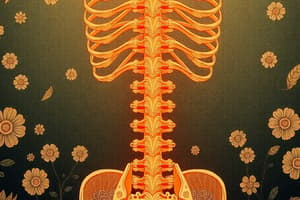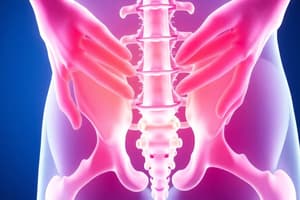Podcast
Questions and Answers
The acronym SAMPLE stands for Symptoms, Allergies, Medication, Pathologies, Last meal, and ______.
The acronym SAMPLE stands for Symptoms, Allergies, Medication, Pathologies, Last meal, and ______.
Environment
Signs of uveitis are associated with the ______ symptoms of seronegative spondyloarthritis.
Signs of uveitis are associated with the ______ symptoms of seronegative spondyloarthritis.
Eyes
An X-ray can be used to check for fractures, osteoarthritis, and ______.
An X-ray can be used to check for fractures, osteoarthritis, and ______.
osteophytes
A clear (colorless) synovial fluid indicates a ______ condition.
A clear (colorless) synovial fluid indicates a ______ condition.
A white (cloudy) synovial fluid indicates the presence of ______.
A white (cloudy) synovial fluid indicates the presence of ______.
Seronegative spondyloarthritis includes types such as ankylosing spondylitis and ______ arthritis.
Seronegative spondyloarthritis includes types such as ankylosing spondylitis and ______ arthritis.
Ar/cular disorders may cause deep ______
Ar/cular disorders may cause deep ______
In the context of laboratory tests, a high viscosity of synovial fluid is considered ______.
In the context of laboratory tests, a high viscosity of synovial fluid is considered ______.
Inflammatory conditions can be classified as septic arthritis, crystal-induced, and ______ arthritis.
Inflammatory conditions can be classified as septic arthritis, crystal-induced, and ______ arthritis.
Non-ar/cular disorders often lead to localized ______
Non-ar/cular disorders often lead to localized ______
Inflammatory disorders may include local symptoms like erythema, warmth, pain, or ______
Inflammatory disorders may include local symptoms like erythema, warmth, pain, or ______
Common laboratory findings in inflammatory disorders include elevated erythrocyte sedimenta9on rate [ESR] and ______
Common laboratory findings in inflammatory disorders include elevated erythrocyte sedimenta9on rate [ESR] and ______
Rheumatoid arthritis can cause boutonnière deformity which results in ______ of the PIP joint.
Rheumatoid arthritis can cause boutonnière deformity which results in ______ of the PIP joint.
Women are more likely to suffer from rheumatoid arthritis and ______
Women are more likely to suffer from rheumatoid arthritis and ______
The swan-neck deformity leads to hyperextension of the PIP joint and ______ of the DIP joint.
The swan-neck deformity leads to hyperextension of the PIP joint and ______ of the DIP joint.
Elderly patients commonly experience osteoarthritis and ______ rheumatica.
Elderly patients commonly experience osteoarthritis and ______ rheumatica.
Episodes of CPPD-induced inflamma9on are associated with low-grade ______.
Episodes of CPPD-induced inflamma9on are associated with low-grade ______.
Also referred to as a 'Z-deformity,' the 'piano key' ulnar head is secondary to destruction of the ulnar collateral ligament leading to a floating ulnar ______.
Also referred to as a 'Z-deformity,' the 'piano key' ulnar head is secondary to destruction of the ulnar collateral ligament leading to a floating ulnar ______.
Treatment for acute cases may involve rest and intraarticular ______.
Treatment for acute cases may involve rest and intraarticular ______.
Sclerosis of the bone and osteophytes are typical of ______, while osteopenia and symmetry are typical of rheumatoid arthritis.
Sclerosis of the bone and osteophytes are typical of ______, while osteopenia and symmetry are typical of rheumatoid arthritis.
Psoriatic arthritis occurs in ______% of patients with cutaneous psoriasis.
Psoriatic arthritis occurs in ______% of patients with cutaneous psoriasis.
Marginal erosion is typical of ______ arthritis and can be seen with X-rays.
Marginal erosion is typical of ______ arthritis and can be seen with X-rays.
Ping and ridging of the nails are common signs of ______.
Ping and ridging of the nails are common signs of ______.
Reactive arthritis is a complication following an infection elsewhere in the ______.
Reactive arthritis is a complication following an infection elsewhere in the ______.
ESR is usually elevated in patients with ______.
ESR is usually elevated in patients with ______.
C-reactive protein (CRP) is usually elevated and may be more ideal than ESR in following disease ______.
C-reactive protein (CRP) is usually elevated and may be more ideal than ESR in following disease ______.
Clinical manifestations of reactive arthritis can be triggered by enteric and ______ infections.
Clinical manifestations of reactive arthritis can be triggered by enteric and ______ infections.
Additive arthritis or tendinitis are part of the ______ manifestations of reactive arthritis.
Additive arthritis or tendinitis are part of the ______ manifestations of reactive arthritis.
The most common clinically available ACPA is called antibody to cyclic ______ peptide.
The most common clinically available ACPA is called antibody to cyclic ______ peptide.
Arthritis in reactive cases typically persists for ______ months.
Arthritis in reactive cases typically persists for ______ months.
Gout is caused by deposition of monosodium urate monohydrate crystals in and around ______ joints.
Gout is caused by deposition of monosodium urate monohydrate crystals in and around ______ joints.
The risk of developing gout increases with age and with serum ______ acid levels.
The risk of developing gout increases with age and with serum ______ acid levels.
The classical presentation of gout is with an acute ______, affecting the first MTP joint in over 50% of cases.
The classical presentation of gout is with an acute ______, affecting the first MTP joint in over 50% of cases.
Typical features of gout include severe pain, often described as the 'worst pain ever,' and ______ tenderness.
Typical features of gout include severe pain, often described as the 'worst pain ever,' and ______ tenderness.
In gout, identification of urate crystals in the aspirate from a joint, bursa, or ______ is essential.
In gout, identification of urate crystals in the aspirate from a joint, bursa, or ______ is essential.
Oral ______ is the treatment of first choice in acute gout.
Oral ______ is the treatment of first choice in acute gout.
Calcium pyrophosphate deposition disease is most common in the ______, occurring in 10–15% of those aged 65–75 years.
Calcium pyrophosphate deposition disease is most common in the ______, occurring in 10–15% of those aged 65–75 years.
Definitive diagnosis of CPPD arthritis requires demonstration of typical ______ or rodlike crystals in synovial fluid.
Definitive diagnosis of CPPD arthritis requires demonstration of typical ______ or rodlike crystals in synovial fluid.
Decreased levels of cartilage glycosaminoglycans normally inhibit and regulate ______ nucleation.
Decreased levels of cartilage glycosaminoglycans normally inhibit and regulate ______ nucleation.
CPPD arthropathy may cause acute synovitis superimposed on ______ joints.
CPPD arthropathy may cause acute synovitis superimposed on ______ joints.
Flashcards
SAMPLE history taking
SAMPLE history taking
A medical history taking process using the acronym SAMPLE. It helps understand the patient's symptoms, allergies, medications, previous conditions, last meal, and circumstances leading to their visit.
Ankylosing Spondylitis
Ankylosing Spondylitis
A type of arthritis characterized by inflammation of the spine and surrounding joints, often affecting the sacroiliac joint.
Septic Arthritis
Septic Arthritis
Joint inflammation caused by bacteria or other microorganisms.
Crystal-induced arthritis
Crystal-induced arthritis
Signup and view all the flashcards
Spondyloarthritis
Spondyloarthritis
Signup and view all the flashcards
Psoriatic Arthritis
Psoriatic Arthritis
Signup and view all the flashcards
Reactive Arthritis
Reactive Arthritis
Signup and view all the flashcards
IBD-associated Arthritis
IBD-associated Arthritis
Signup and view all the flashcards
What is an Articular Disorder?
What is an Articular Disorder?
Signup and view all the flashcards
What is a Non-articular Disorder?
What is a Non-articular Disorder?
Signup and view all the flashcards
What are the Signs of an Inflammatory Disorder?
What are the Signs of an Inflammatory Disorder?
Signup and view all the flashcards
What are the Signs of a Non-inflammatory Disorder?
What are the Signs of a Non-inflammatory Disorder?
Signup and view all the flashcards
How does Age Affect Rheumatic Disorders?
How does Age Affect Rheumatic Disorders?
Signup and view all the flashcards
How does Gender Affect Rheumatic Disorders?
How does Gender Affect Rheumatic Disorders?
Signup and view all the flashcards
What are Common Laboratory Tests for Rheumatic Disorders?
What are Common Laboratory Tests for Rheumatic Disorders?
Signup and view all the flashcards
What are Common Hand Deformities in Rheumatoid Arthritis?
What are Common Hand Deformities in Rheumatoid Arthritis?
Signup and view all the flashcards
Piano Key Deformity
Piano Key Deformity
Signup and view all the flashcards
Gout
Gout
Signup and view all the flashcards
Sclerosis and osteophytes
Sclerosis and osteophytes
Signup and view all the flashcards
Osteopenia and symmetry
Osteopenia and symmetry
Signup and view all the flashcards
Rheumatoid Factor (RF)
Rheumatoid Factor (RF)
Signup and view all the flashcards
Anti-cyclic citrullinated peptide (anti-CCP)
Anti-cyclic citrullinated peptide (anti-CCP)
Signup and view all the flashcards
Antinuclear antibodies (ANA)
Antinuclear antibodies (ANA)
Signup and view all the flashcards
Erythrocyte Sedimentation Rate (ESR)
Erythrocyte Sedimentation Rate (ESR)
Signup and view all the flashcards
What is Pseudogout?
What is Pseudogout?
Signup and view all the flashcards
What is a key sign of a bacterial infection in a patient with Pseudogout?
What is a key sign of a bacterial infection in a patient with Pseudogout?
Signup and view all the flashcards
What are some treatment options for acute Pseudogout?
What are some treatment options for acute Pseudogout?
Signup and view all the flashcards
What is a common treatment for recurrent Pseudogout?
What is a common treatment for recurrent Pseudogout?
Signup and view all the flashcards
What is Ankylosing Spondylitis?
What is Ankylosing Spondylitis?
Signup and view all the flashcards
What is Psoriatic Arthritis?
What is Psoriatic Arthritis?
Signup and view all the flashcards
What is Reactive Arthritis?
What is Reactive Arthritis?
Signup and view all the flashcards
How does Reactive Arthritis present?
How does Reactive Arthritis present?
Signup and view all the flashcards
Tophi
Tophi
Signup and view all the flashcards
Calcium Pyrophosphate Deposition Disease (CPPD)
Calcium Pyrophosphate Deposition Disease (CPPD)
Signup and view all the flashcards
Pseudogout
Pseudogout
Signup and view all the flashcards
Serum Uric Acid Level
Serum Uric Acid Level
Signup and view all the flashcards
Colchicine
Colchicine
Signup and view all the flashcards
Allopurinol
Allopurinol
Signup and view all the flashcards
NSAID (Non-Steroidal Anti-Inflammatory Drug)
NSAID (Non-Steroidal Anti-Inflammatory Drug)
Signup and view all the flashcards
Study Notes
Orthopedic - Rheumatology
- History Taking (SAMPLE): Symptoms, Allergies, Medications, Past illnesses, Last meal, and Environment. Essential for understanding patient's condition.
- Symptoms of Seronegative Spondyloarthritis: Uveitis (eye inflammation), Psoriasis (skin), signs of Sacroiliitis(axial structure), spondylitis(spinal inflammation), Peripheral arthritis & enthesitis (inflammation at the attachment points of tendons and ligaments), and Inflammatory Bowel Disease (gut).
- Imaging (1.1): X-rays for fracture, osteoarthritis (osteophytes, joint narrowing, calcifications), osteolysis, osteoporosis. MRIs for edema, bone bruises, ligaments, and meniscal conditions.
- Laboratory Tests (1.2): Synovial fluid analysis checking color (clear, yellow, dark yellow = inflammation, white= crystal), WBC count (normal, inflammation, septic), viscosity (normal, inflammatory, infectious).
- Classification of Arthritis: Non-inflammatory (osteoarthritis), Inflammatory (septic arthritis, crystal-induced - gout, pseudogout, seropositive - rheumatoid arthritis, lupus, Sjogren's, seronegative - spondyloarthritis, axial - ankylosing spondylitis, peripheral - psoriatic arthritis, reactive arthritis, Inflammatory bowel disease).
Articular vs Non-articular Disorders
- Articular Disorders: Deep pain, limited/painful active & passive range of motion, joint swelling, crepitation (a grating sound), joint instability, joint locking.
- Non-articular Disorders: Localized pain, painful active range of motion (but not passive), the pain is away/distant from the joint (not in the joint itself), joint swelling (less common), joint instability (less common), and deformity.
Inflammatory vs Non-inflammatory Disorders
- Inflammatory Disorders: Localized symptoms (redness, warmth, pain, swelling). Systemic symptoms (fatigue, fever, rash, weight loss). Elevated erythrocyte sedimentation rate (ESR), C-reactive protein (CRP), thrombocytosis, or hypoalbuminemia (low protein).
Clinical History
- Age: Different conditions (e.g., Systemic Lupus Erythematosus [SLE] - young, Rheumatoid Arthritis - middle age, Osteoarthritis & polymyalgia rheumatica - elderly).
- Sex: Gout, spondylarthritis, and ankylosing spondylitis (men); rheumatoid arthritis, fibromyalgia, osteoporosis, lupus (women).
Laboratory Investigations
- Complete blood count (CBC), ESR, CRP, serum uric acid, RF, CCP, ANAs, complement levels, Lyme antibodies, ANCA, Antistreptolysin O (ASO) levels. All helpful in determining the type of arthritis.
Rheumatoid Arthritis
- Common Hand Deformities: Fusiform swelling (spindle-shaped), Boutonnière deformity (flexion of PIP and hyperextension of DIP), Swan-neck deformity (flexion contracture of MCP, hyperextension of PIP, and flexion of DIP), Hitchhiker thumb (hyperextension of IP joint), and piano key ulnar head deformity
- Rheumatoid Arthritis vs Osteoarthritis: Comparing these conditions and the characteristics of osteoarthritis which include sclerosis, osteophytes, osteopenia, asymmetry of pain, and less common presence of cysts and narrowing on x-rays.
Laboratory Findings in RA Patients
- ESR, CRP: Usually elevated in inflammatory conditions like RA, but may be normal in early stages of RA, or elevated due to hypergammaglobulinemia.
- RF: Positive in 60-80% of RA cases, but can be present in other conditions.
- ACPA: More specific for RA than RF, positive in 70-80% of RA patients
- ANAs: May be present in other autoimmune conditions (30-50% in RA).
Crystal-Induced Arthritis (Gout)
- Features: Acute monoarthritis, often affecting the first metatarsophalangeal (MTP) joint, severe pain, swelling, redness, and extreme tenderness. Typically begins suddenly, especially in the early morning. Self-limiting over 5-14 days.
- Investigation: Identify Urate Crystals in synovial fluid via aspiration. Biochemical screen (assessments for kidney function, acid, glucose and lipid profile for metabolic syndrome, elevated ESR, CRP, and neutrophilia levels).
- Treatment (Acute): Colchicine (oral), oral prednisolone, and intramuscular methylprednisolone. Colchicine is usually the first choice of treatment in acute gout.
Calcium Pyrophosphate Deposition Disease (CPPD)
- Features: Common in the elderly, asymptomatic to chronic conditions. Can cause acute synovitis.
- Diagnosis: Requires identification of rhomboid or rod-like crystals in the synovial fluid.
- Treatment (Acute): Rest, joint aspiration, Nonsteroidal anti-inflammatory drugs (NSAIDs), or intra-articular glucocorticoid injections. (Chronic) - in frequent cases, daily prophylactic colchicine or short courses of glucocorticoids may reduce frequency of attacks.
Psoriatic Arthritis
- A progressive inflammatory musculoskeletal disease, common in patients with psoriasis (5-30% of them). Symptoms can occur before skin manifestation
Transient Synovitis/Septic Arthritis, Legg-Calvé-Perthes
- Differential Diagnosis of issues of the hip joint that presents similarly to other types of arthritis
- Laboratory Investigation (CBC [complete blood count], ESR, and CRP results for determining the cause of the hip pain.
Reactive/Post-Infective Arthritis
- Definition: Arthritis or enthesitis, resulting from an infection elsewhere in the body (bacterial infection, genital or gastrointestinal infections).
- Clinical Features: Monoarthritis, or multiple joints involvement. Symptoms range from a transient monoarthritis to chronic conditions. Typically resolve within 3 to 5 months, but may become chronic.
Studying That Suits You
Use AI to generate personalized quizzes and flashcards to suit your learning preferences.





